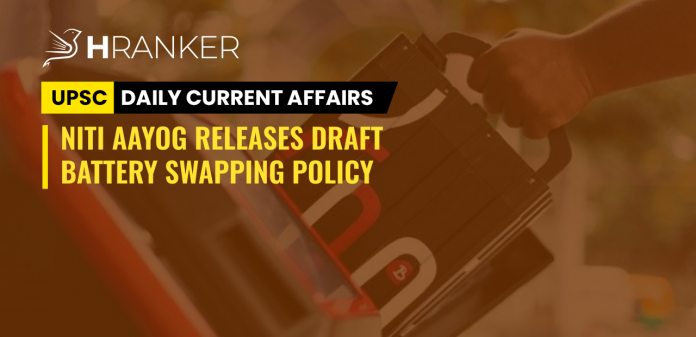WHAT’S IN NEWS:
The NITI Aayog on Thursday released a draft battery swapping policy targeted at electric two and three wheelers as the government think tank aims to expedite large scale adoption of Electric Vehicles.
Internet of Things (IOT): It describes physical objects (or groups of such objects) with sensors, processing ability, software, and other technologies that connect and exchange data with other devices and systems over the Internet or other communications networks. Internet of things has been considered a misnomer because devices do not need to be connected to the public internet, they only need to be connected to a network and be individually addressable
BATTERY SWAPPING:
It is the mechanism that involves exchanging discharged batteries for charged ones over a battery swapping station while delinking the vehicle and fuel.
KEY FEATURES OF THE DRAFT POLICY:
- The policy aims at providing subsidies to battery developers provided the battery swapping ecosystem that they represent satisfies the technical and operational requirements.
- It suggests that GST council should consider reducing the GST on lithium-ion batteries to 5%. As per the current GST requirements, the tax rates on lithium-ion batteries and EV supply equipment are 18% & 5 % respectively.
- It proposes that demand side incentives offered under existing or new schemes for EV purpose can be made available to EVs with swapping batteries eligible under the policy.
- The policy prioritises all metropolitan cities with a population greater than 4 million for developments of battery swapping networks under the first phase (1-2) years, followed by all major cities such as States capitals, UT headquarters and cities with population greater than 5 lakh in the next 2-3 years.
- To ensure battery safety and security of assets, Swappable batteries would be equipped with advanced features such as IOT based battery monitoring systems, remote monitoring, and immobilization capabilities.
- The policy also requires state governments to ensure that public battery charging stations are eligible for EV power connections with concessional tariffs.
- It also proposes to bring such stations under existing or future time-of-day (ToD) tariff regimes, so that the swappable batteries can be charged during off-peak periods when electricity tariffs are low.
- The policy also proposes to assign a unique identification number (UIN) to swappable batteries at the manufacturing stage to help track and monitor them. Similarly, a UIN number will be assigned to each battery swapping station.
- It also proposes to install battery swapping stations at several locations like retail fuel outlets, public parking areas, malls, kirana shops and general stores etc.
MAJOR INTENDED BENEFITS OF POLICY:
- The policy is expected to make mass production and deployment of lithium-ion batteries possible.
- Batteries swapping involved user purchasing an EV without the battery, thus significantly lowering upfront costs.
- It will enable the EV buyer to pay a regular subscription fee to service providing for battery services throughout the vehicles life.
- It will help contribute to the decarbonizing vision of the government aimed at transition to clean mobility, led by electric vehicles.
ISSUES WITH EV INFRASTRUCTURE IN INDIA:
- Space constrain in urban areas for setting up charging stations at scale.
- High EV and battery costs especially in a situation where the battery needs to be replaced every 6 to 7 years and costs almost three- fourth of the vehicle’s cost.
- No universal charges and charging ecosystem as different companies are manufacturing their own different charging ports leading to lack of standardization.
- The EV battery gives ideal performance in temperature range of 15-40 degree celsius. So, it is not efficient in too cold or too hot regions.
- Higher adoption of EVs will lead to a huge surge in electricity demands which can lead to greater pollution through excess burning fossil fuel for electricity generation.
OTHER GOVERNMENT SCHEMES FOR EV PROMOTION:
Faster Adoption and Manufacturing of Hybrid and Electrical Vehicles (FAME) Scheme: It is in its second phase under National Electric Mobility Mission Plan (NEMMP) w.e.f April 2019 with budgetary support of 10000 crores. It is being implemented for three years. It supports approximately 7000 e-buses, 5 lakh e-3 Wheelers, 55000 e-4 Wheeler Passenger Cars, 10 lakh e-2 Wheelers and the creation of charging infrastructure.




